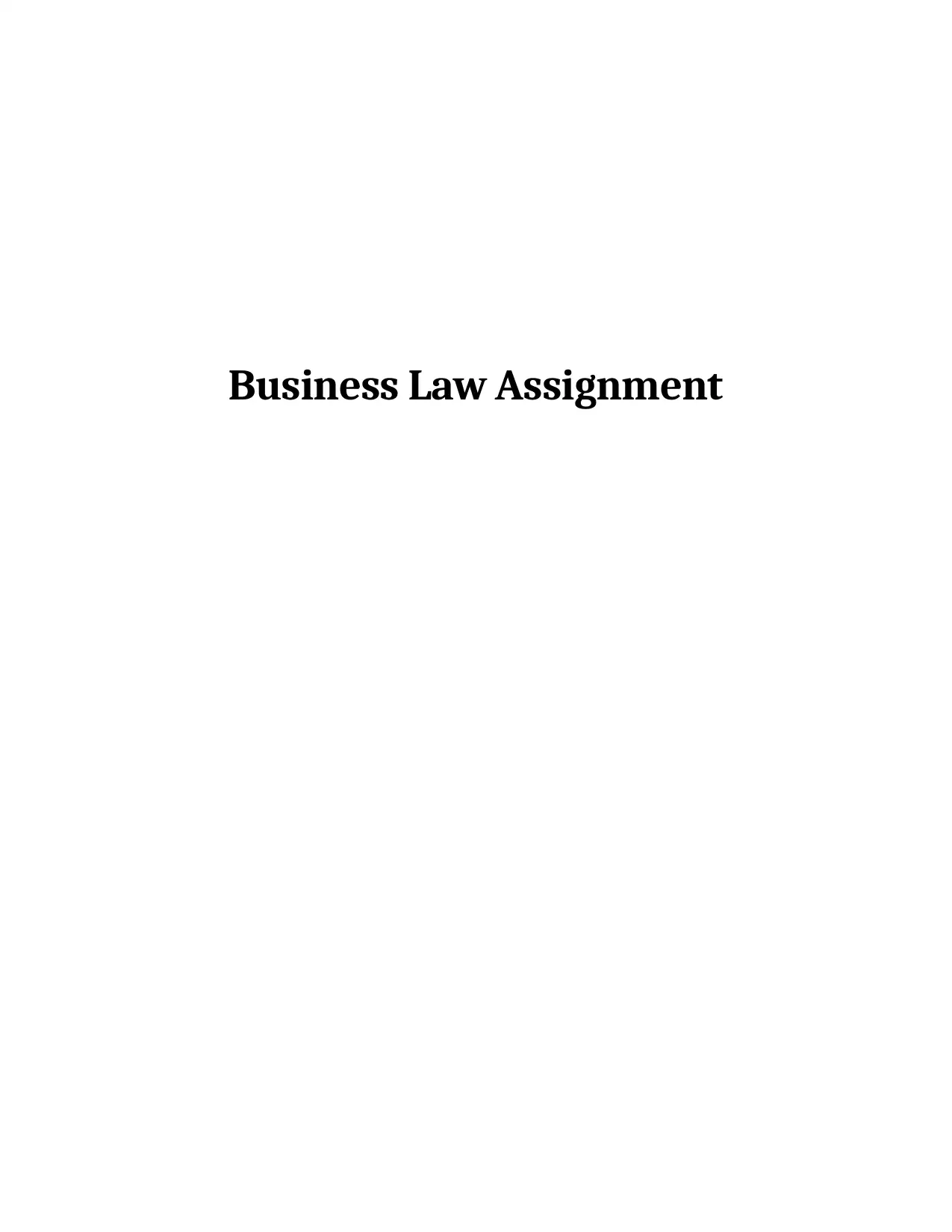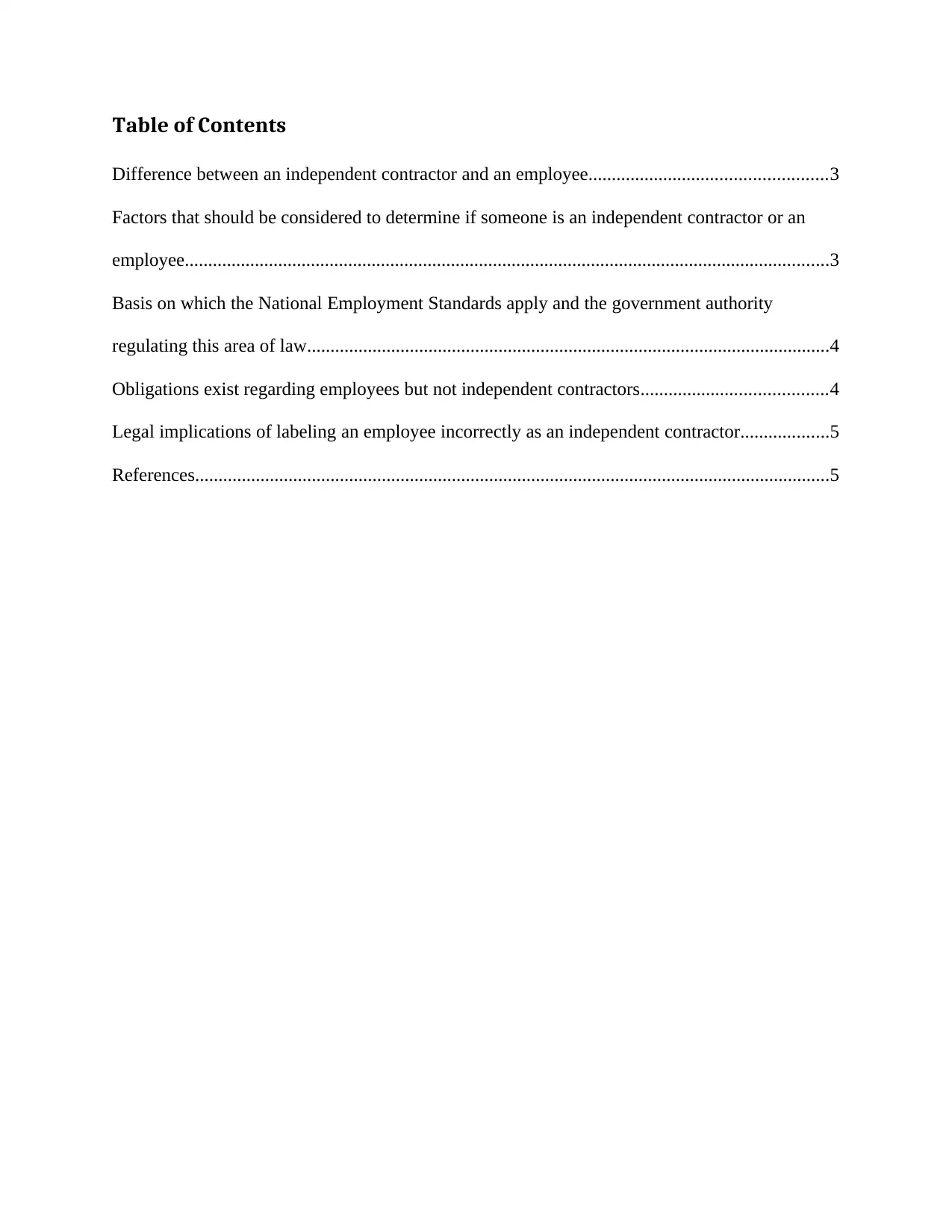Business Law: Analysis of Employee vs. Independent Contractor Status
VerifiedAdded on 2023/06/11
|5
|865
|196
Report
AI Summary
This report provides a detailed analysis of the differences between an independent contractor and an employee, focusing on aspects such as job description, income source, benefits, work hours, control, and tax payments. It outlines the factors that determine whether a worker is an independent contractor or an employee, including behavioral control, financial control, and the type of relationship established with the company. The report also discusses the National Employment Standards, their application based on fair work policies, and the role of the Fair Work Ombudsman in regulating this area of law. Furthermore, it highlights the obligations that exist for employees but not for independent contractors, such as honesty, adherence to employer directions, efficient performance, and confidentiality. Finally, it addresses the legal implications of incorrectly labeling an employee as an independent contractor, including potential penalties, reputational damage, and claims for payback from the misclassified employee.

Business Law Assignment
Paraphrase This Document
Need a fresh take? Get an instant paraphrase of this document with our AI Paraphraser

Table of Contents
Difference between an independent contractor and an employee...................................................3
Factors that should be considered to determine if someone is an independent contractor or an
employee..........................................................................................................................................3
Basis on which the National Employment Standards apply and the government authority
regulating this area of law................................................................................................................4
Obligations exist regarding employees but not independent contractors........................................4
Legal implications of labeling an employee incorrectly as an independent contractor...................5
References........................................................................................................................................5
Difference between an independent contractor and an employee...................................................3
Factors that should be considered to determine if someone is an independent contractor or an
employee..........................................................................................................................................3
Basis on which the National Employment Standards apply and the government authority
regulating this area of law................................................................................................................4
Obligations exist regarding employees but not independent contractors........................................4
Legal implications of labeling an employee incorrectly as an independent contractor...................5
References........................................................................................................................................5

Difference between an independent contractor and an employee
An employee and an independent contractor can be discriminated on basis of various parameters
like job description, source of income, benefits, work hours, relationship with organization,
control, and cost and tax payment. An employee is hired by a company on salary basis while an
independent contractor is hired on contract and pay basis. The source of income for an employee
is his salary while an independent contractor gets incentives from each project. The employees
get the company benefits and the independent contractors enjoy no such company benefits. The
work hours for employees are set by a company and for the independent contractor work hours
are set by him. The employees share employee-employer relationship with the company and
independent contractor has business- client relationship with the company. The employees work
under the control of an employer and independent contractor works independently. The
employees are paid for the overtime and are not obliged for the cost incurred in performing the
work while the independent contractors are not paid overtime and have to incur the cost
associated with the performance of work. The employees get tax deduction and the independent
employer has to pay their tax to Australian Taxation Office.
Factors that should be considered to determine if someone is an
independent contractor or an employee
Behavioral Control
If a person is trained and directed by an employer about how and what work is to be performed
by the person, he is considered as an employee. If a person himself can set the work hours for
him, he is considered as independent contractor.
Financial Control
If a worker can work for other companies and is paid for the performed task is considered as
independent contractor. And if a person is restricted to work with other companies and is paid on
salary basis, it is considered as an employee.
An employee and an independent contractor can be discriminated on basis of various parameters
like job description, source of income, benefits, work hours, relationship with organization,
control, and cost and tax payment. An employee is hired by a company on salary basis while an
independent contractor is hired on contract and pay basis. The source of income for an employee
is his salary while an independent contractor gets incentives from each project. The employees
get the company benefits and the independent contractors enjoy no such company benefits. The
work hours for employees are set by a company and for the independent contractor work hours
are set by him. The employees share employee-employer relationship with the company and
independent contractor has business- client relationship with the company. The employees work
under the control of an employer and independent contractor works independently. The
employees are paid for the overtime and are not obliged for the cost incurred in performing the
work while the independent contractors are not paid overtime and have to incur the cost
associated with the performance of work. The employees get tax deduction and the independent
employer has to pay their tax to Australian Taxation Office.
Factors that should be considered to determine if someone is an
independent contractor or an employee
Behavioral Control
If a person is trained and directed by an employer about how and what work is to be performed
by the person, he is considered as an employee. If a person himself can set the work hours for
him, he is considered as independent contractor.
Financial Control
If a worker can work for other companies and is paid for the performed task is considered as
independent contractor. And if a person is restricted to work with other companies and is paid on
salary basis, it is considered as an employee.
⊘ This is a preview!⊘
Do you want full access?
Subscribe today to unlock all pages.

Trusted by 1+ million students worldwide

Type of relationship
Independent contractor has a specific contract with a company. An employee works under an
employer and has employee relationship with the company (Fairwork, 2018).
Basis on which the National Employment Standards apply and
the government authority regulating this area of law
The National Employment Standards apply on the basis of fair work policies for the employees.
It includes maximum weekly hours, flexible working arrangement, leaves, public holidays,
termination notice and fair work information system. The National Employment Standards were
introduced in January 2010.
The Fair Work Ombudsman council of Australian Government regulates this area of law
(Professionals Australia, 2018).
Obligations exist regarding employees but not independent contractors
The employees are obliged for a certain set of duties or responsibilities. The employees are
required to work honestly and not to disrupt the business. The employees have to follow the
direction and orders of the employer strictly. They have to deliver efficient and timely
performance. They should not disclose any confidential information of the business organization.
They should not be found guilty of taking any kind of bribe. They should corporate with the
employer and agree upon the fixed working hours. The employees should work with reasonable
care for health and safety of them and others at workplace (Government of Western Australia,
2018).
Independent contractor has a specific contract with a company. An employee works under an
employer and has employee relationship with the company (Fairwork, 2018).
Basis on which the National Employment Standards apply and
the government authority regulating this area of law
The National Employment Standards apply on the basis of fair work policies for the employees.
It includes maximum weekly hours, flexible working arrangement, leaves, public holidays,
termination notice and fair work information system. The National Employment Standards were
introduced in January 2010.
The Fair Work Ombudsman council of Australian Government regulates this area of law
(Professionals Australia, 2018).
Obligations exist regarding employees but not independent contractors
The employees are obliged for a certain set of duties or responsibilities. The employees are
required to work honestly and not to disrupt the business. The employees have to follow the
direction and orders of the employer strictly. They have to deliver efficient and timely
performance. They should not disclose any confidential information of the business organization.
They should not be found guilty of taking any kind of bribe. They should corporate with the
employer and agree upon the fixed working hours. The employees should work with reasonable
care for health and safety of them and others at workplace (Government of Western Australia,
2018).
Paraphrase This Document
Need a fresh take? Get an instant paraphrase of this document with our AI Paraphraser

Legal implications of labeling an employee incorrectly as an
independent contractor
The employer faces various penalties for misclassification of employ as an independent
contractor. The employer faces a liability of up to $ 3000 per misclassification or violation. The
employer has to deal with the damage in the reputation of the organization in case of avoiding
any obligation. The employee misclassified can claim for pay back from employer and even the
employer can be charged for a penalty go $1000 with the imprisonment of one year for the
misclassification of employees (Shieldgeo, 2018).
References
Fairwork (2018) Independent contractors and employees [online]. Available from:
https://www.fairwork.gov.au/how-we-will-help/templates-and-guides/fact-sheets/rights-and-
obligations/independent-contractors-and-employees [Accessed 21 May 2018].
Government of Western Australia (2018) Employees - your rights and responsibilities [online].
Available from: https://www.commerce.wa.gov.au/worksafe/employees-your-rights-and-
responsibilities [Accessed 21 May 2018].
Professionals Australia (2018) National Employment Standards [online]. Available from:
http://www.professionalsaustralia.org.au/australian-government/support/rights-wages-
conditions/national-employment-standards/ [Accessed 21 May 2018].
Shieldgeo (2018) Implications of Misclassification: A Country Focus [online]. Available from:
http://shieldgeo.com/implications-of-misclassification-a-country-focus/ [Accessed 21 May
2018].
independent contractor
The employer faces various penalties for misclassification of employ as an independent
contractor. The employer faces a liability of up to $ 3000 per misclassification or violation. The
employer has to deal with the damage in the reputation of the organization in case of avoiding
any obligation. The employee misclassified can claim for pay back from employer and even the
employer can be charged for a penalty go $1000 with the imprisonment of one year for the
misclassification of employees (Shieldgeo, 2018).
References
Fairwork (2018) Independent contractors and employees [online]. Available from:
https://www.fairwork.gov.au/how-we-will-help/templates-and-guides/fact-sheets/rights-and-
obligations/independent-contractors-and-employees [Accessed 21 May 2018].
Government of Western Australia (2018) Employees - your rights and responsibilities [online].
Available from: https://www.commerce.wa.gov.au/worksafe/employees-your-rights-and-
responsibilities [Accessed 21 May 2018].
Professionals Australia (2018) National Employment Standards [online]. Available from:
http://www.professionalsaustralia.org.au/australian-government/support/rights-wages-
conditions/national-employment-standards/ [Accessed 21 May 2018].
Shieldgeo (2018) Implications of Misclassification: A Country Focus [online]. Available from:
http://shieldgeo.com/implications-of-misclassification-a-country-focus/ [Accessed 21 May
2018].
1 out of 5
Related Documents
Your All-in-One AI-Powered Toolkit for Academic Success.
+13062052269
info@desklib.com
Available 24*7 on WhatsApp / Email
![[object Object]](/_next/static/media/star-bottom.7253800d.svg)
Unlock your academic potential
Copyright © 2020–2025 A2Z Services. All Rights Reserved. Developed and managed by ZUCOL.




